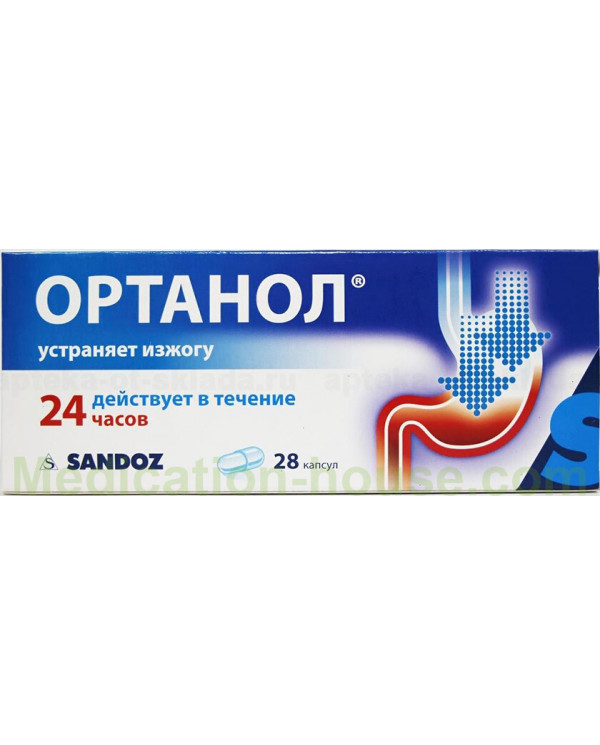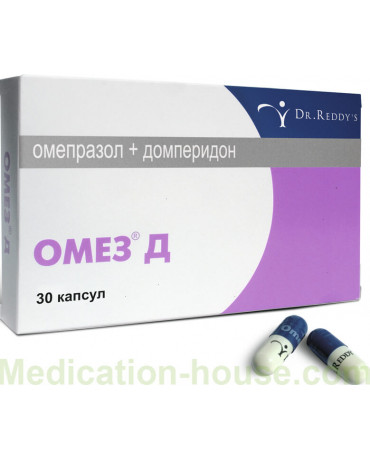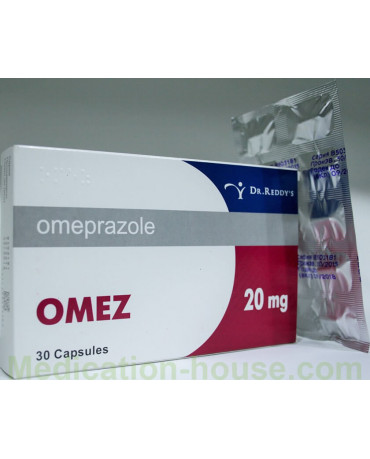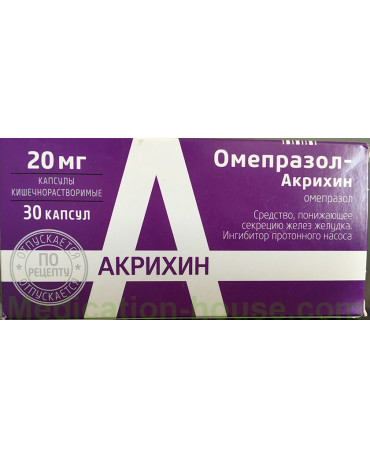Ortanol instruction
You can buy Ortanol here
Ortanol is an inhibitor of H + -K + -ATPase, an antiulcer agent.
Release form and composition
Dosage forms of Ortanol:
Capsules size No. 3: solid, with a body and a lid of light pinkish-brown color, on which there is an inscription "OME 10" in black; contents - granules of light yellow color (7 pcs. in blisters, 1, 2 or 4 blisters in a package);
Capsules size No. 2: solid, with a body and a lid of white color, on which there is an inscription "OME 20" black; contents - granules of light yellow color (7 pcs. in blisters, 1, 2 or 4 blisters in a package);
Capsules size No. 1: solid, with a light pinkish-brown body and white cap, on which there is an inscription "OME 40" in black; contents - granules of light yellow color (7 pcs. in blisters, 1, 2 or 4 blisters in a package);
Lyophilisate for solution for infusion: powder or mass of almost white or white (40 mg each in transparent glass bottles, in a pack of cardboard 1, 5 or 10 bottles).
The active substance of Ortanol is omeprazole:
1 capsule - 10 mg (size No. 3), 20 mg (size No. 2) or 40 mg (size No. 1);
1 bottle of lyophilisate - 40 mg.
Auxiliary components of capsules: anhydrous lactose, microcrystalline cellulose, croscarmellose sodium, low-substituted hyprolose, povidone, hypromellose phthalate, polysorbate 80, talc, dibutylsebacate.
The composition of the capsule shell:
Capsules 10 mg: hypromellose, carrageenan, potassium chloride, titanium dioxide, water, iron (III) oxide yellow and oxide red; ink for printing - shellac, propylene glycol, anhydrous isopropanol, anhydrous ethanol, ammonium hydroxide, potassium hydroxide, purified water, iron (III) black oxide (E172);
Capsules 20 mg: titanium dioxide, carrageenan, hypromellose, water, potassium chloride; ink for the inscription - ammonium hydroxide, anhydrous ethanol, butanol, anhydrous isopropanol, shellac, potassium hydroxide, propylene glycol, purified water, iron (III) black oxide (E172);
Capsules 40 mg: potassium chloride, carrageenan, titanium dioxide, hypromellose, water, iron (III) oxide red and oxide yellow; Ink for application: ammonium hydroxide, butanol, potassium hydroxide, anhydrous ethanol, propylene glycol, shellac, anhydrous isopropanol, purified water, iron (III) oxide black (E172).
Auxiliary components of the lyophilisate: disodium edetate dihydrate, sodium hydroxide.
Pharmacodynamics
The mechanism of action of the drug
Omeprazole is a racemic mixture of two enantiomers that causes a decrease in the secretion of gastric juice through a highly selective mechanism of action. Being a weak base, omeprazole accumulates in the secretory tubules of the parietal cells of the stomach and is activated by inhibiting the enzyme H +, K + -ATPase. The degree of influence of the active substance on the process of hydrochloric acid formation is dose-dependent. As a result, regardless of the stimulating factor, basal and stimulated secretion of hydrochloric acid is inhibited. After a single oral administration, omeprazole begins to act during the first hour. The action of Ortanol lasts for 1 day. The maximum effect is achieved 2 hours after taking omeprazole. After stopping the use of Ortanol, a complete restoration of secretory activity occurs after 3-5 days.
Effect on hydrochloric acid secretion
In the case of oral administration of omeprazole once a day, day and night secretion of gastric juice is rapidly and effectively inhibited. The maximum effect is ensured during treatment for 3-5 days. With peptic ulcer of the duodenum, taking omeprazole in a dose of 20 mg leads to a decrease in daily gastric acidity by 80%. On average, maximum acid secretion as a result of stimulation with pentagastrin after 24 hours is approximately 70%. In such patients, with oral administration of omeprazole at a dose of 20 mg, the average intragastric pH is> 3 for 17 hours a day.
Inhibition of acid secretion is affected by the area under the concentration-time curve (AUC) and is not affected by the plasma concentration of omeprazole at a particular point in time.
Effects on Helicobacter pylori
In vitro, omeprazole has a bactericidal effect on H. pylori. In the case of the combined use of omeprazole and antibacterial drugs, H. pylori is eradicated, as a result of which the symptoms are quickly eliminated, a high degree of healing of defects of the gastrointestinal tract is ensured. The result is also a long-term remission of peptic ulcer, which reduces the likelihood of bleeding and other complications with the same effectiveness as with constant maintenance therapy.
Other effects due to inhibition of acid secretion
There is evidence that with prolonged treatment, the frequency of formation of glandular cysts in the stomach increases slightly. Similar changes that result from inhibition of hydrochloric acid secretion are benign and are reversible with continued therapy.
With a decrease in the secretion of hydrochloric acid in the stomach under the action of proton pump inhibitors or other acid-inhibiting factors, the risk of developing intestinal infections caused by the following pathogens may slightly increase: Campylobacter spp., Salmonella spp. and possibly Clostridium difficile.
When using drugs that reduce the secretion of the glands of the stomach, the content of gastrin in the blood serum increases. Due to a decrease in the concentration of hydrochloric acid, the concentration of chromogranin A in the blood plasma increases, which can cause false-positive results in the diagnosis of neuroendocrine tumors. To prevent this effect, therapy with proton pump inhibitors should be stopped no later than 5-14 days before the study of the concentration of chromogranin A. If during this period the indicators have not returned to normal levels, the study should be repeated.
With prolonged use of omeprazole in adults and children, an increase in the number of enterochromaffin-like cells was recorded, possibly due to an increase in the content of gastrin in the blood serum. This phenomenon does not have clinical significance.
Pharmacokinetics
Omeprazole is rapidly absorbed in the gastrointestinal tract. The time to reach maximum plasma concentration is 1-2 hours. The antisecretory effect occurs within the first hour after oral administration and reaches a maximum after 2 hours. Omeprazole is absorbed in the small intestine, the process is complete in 3-6 hours. About 50% of the maximum secretion is inhibited for 1 day. After taking a single dose, bioavailability is from 30 to 40%, with repeated administration it increases to 60%. With plasma proteins binds to 97%. The volume of distribution is 0.3 l / kg.
In the liver, with the help of cytochrome P450 isoenzymes (CYP), omeprazole is metabolized almost completely, resulting in the formation of six pharmacologically inactive enzymes. The main metabolic pathway is interaction with the CYP2C19 isoenzyme. Another way - using the isoenzyme of cytochrome CYP3A4. Due to the high affinity for CYP2C19 isoenzyme, competitive inhibition and metabolic interactions of omeprazole with other substrates of CYP2C19 isoenzyme are possible. Moreover, due to the low affinity for the CYP3A4 isoenzyme, the active substance does not inhibit the metabolism of other substrates of the CYP3A4 isoenzyme. Also, omeprazole does not have an inhibitory effect on the main isoenzymes of the CYP cytochrome system.
In approximately 15–20% of Asians and 3% of Caucasians, the activity of the CYP2C19 isoenzyme is reduced, that is, they are “slow” metabolizers. In this case, the metabolism of omeprazole probably occurs predominantly using the CYP3A4 isoenzyme. In the case of repeated use of omeprazole at a dose of 20 mg once a day in “slow” metabolizers, the average AUC value is 5–10 times higher than that for patients in whom the activity of the CYP2C19 isoenzyme is normal. In these cases, the average peak plasma concentrations were also 3-5 times higher. The data given do not affect the dosage regimen of Ortanol.
The elimination half-life is from 0.5 to 1 hour. It is excreted by the kidneys in the form of metabolites (from 70 to 80%) and with bile (from 20 to 30%).
The total plasma clearance is from 0.3 to 0.6 l / min.
With impaired liver function, the bioavailability of omeprazole increases, and plasma clearance is significantly reduced.
In case of impaired renal function, significant changes in the pharmacokinetics of omeprazole have not been recorded. In patients with chronic renal failure, excretion decreases in proportion to a decrease in creatinine clearance.
The metabolic rate of omeprazole in elderly patients (over 75 years) is slightly reduced.
Indications for use
Peptic ulcer of the stomach and duodenum (including the prevention of relapse);
Hypersecretory conditions (stressful ulcers of the gastrointestinal tract, Zollinger-Ellison syndrome, systemic mastocytosis, polyendocrine adenomatosis);
Reflux esophagitis;
Gastroesophageal reflux (symptomatic treatment);
Helicobacter pylori eradication in infected patients with peptic ulcer and duodenal ulcer (as one of the components of combination therapy);
Treatment and prevention of damage to the gastric mucosa and duodenum (dyspepsia, peptic ulcer, erosion of the mucous membrane) due to the use of non-steroidal anti-inflammatory drugs (NSAIDs).
Contraindications
Absolute:
Age to 18 years;
Lactation;
The simultaneous use of atazanavir, erlotinib, nelfinavir, posaconazole;
Hypersensitivity to any component of Ortanol or substituted benzimidazoles.
According to the instructions, Ortanol should be used with caution in the following cases:
Renal / hepatic impairment;
Osteoporosis;
The presence of "alarming symptoms": repeated vomiting, vomiting of blood, discoloration of feces (melena), swallowing disorders, significant weight loss, vitamin B12 deficiency;
The period of pregnancy;
The simultaneous use of drugs of St. John's wort, rifampicin, voriconazole, clarithromycin, diazepam, warfarin, clopidogrel, saquinavir, cilostazole, itraconazole, tacrolimus, phenytoin.
Instructions for use Ortanol: method and dosage
Ortanol is taken orally before meals, with a single use - preferably before breakfast: the capsules are swallowed whole and washed down with plenty of water.
For patients who have difficulty swallowing, the capsules can be dissolved in a small amount of fruit juice (for example, orange or apple) or water.
Recommended dosage regimens of Ortanol depending on the indications:
Duodenal ulcer: 20 mg 1 time per day for 2 weeks. If complete scarring after the end of therapy is not noted, conduct another 2-week course;
Peptic ulcer of the duodenum, resistant to therapy: 40 mg once a day for 2-4 weeks;
Peptic ulcer: 20 mg once a day for 4 weeks. If complete scarring after the end of therapy is not noted, conduct another 4-week course;
Gastric ulcer resistant to therapy: 40 mg once a day for 4-8 weeks;
Hypersecretory conditions: the dose is selected individually, the recommended initial dose is 60 mg once a day, the maximum daily dose is 120 mg. If the dose exceeds 80 mg per day, it should be divided into several doses;
Eradication of Helicobacter pylori (in combination with antibacterial agents): 20 mg 2 times a day for 2 weeks;
Reflux esophagitis: 20 mg once a day for a 4-week course. If a complete cure after the end of therapy does not occur, conduct a repeated 4-week course. In severe forms of the disease, the duration of treatment can be extended to 8 weeks;
Damage to the mucous membrane of the gastrointestinal tract as a result of taking NSAIDs: prevention - 20 mg once a day during the entire course of NSAIDs, treatment - 20 mg once a day for 4-8 weeks.
Patients with impaired renal function do not need to adjust the dose. Patients with severe liver disease and the elderly should not exceed a dose of 20 mg per day.
Side effects
From the hemopoietic system: in individual cases - thrombocytopenia, agranulocytosis, pancytopenia, leukopenia;
From the nervous system: in the presence of concomitant severe somatic diseases - headache; rarely - vertigo, insomnia, drowsiness, violation of taste, paresthesia; very rarely - reversible confusion, agitation, depression; in patients with severe liver disease - encephalopathy;
From the digestive system: rarely - flatulence, diarrhea / constipation, abdominal pain, nausea and / or vomiting; very rarely - increased activity of hepatic transaminases and alkaline phosphatase, stomatitis, dry mouth; after severe liver diseases - impaired liver function, hepatitis; with prolonged treatment - the formation of reversible benign gastric glandular cysts;
From the musculoskeletal system: arthralgia, myalgia; in individual cases, muscle weakness;
From the skin: increased sweating, photosensitivity, alopecia, multiforme exudative erythema;
Allergic reactions: rarely - skin itching, urticaria; very rarely - fever, interstitial nephritis, eosinophilia, anaphylactoid reactions, bronchospasm, angioedema;
Other: visual impairment, peripheral edema, gynecomastia.
Side effects that occur as a result of taking Ortanol are usually mild and transient.
Overdose
A single dose of 560 mg omeprazole in adult patients caused symptoms of moderate intoxication. A case of a single dose of omeprazole in a dose of 2400 mg without severe toxic symptoms is also described. In case of increasing the dose, the elimination rate of omeprazole did not change (first-order kinetics). In these cases, specific treatment was not required.
Symptoms: nausea, vomiting, dry mouth, diarrhea, flatulence, headache, increased sweating, dizziness, drowsiness, blurred vision, confusion, tachycardia.
Treatment: symptomatic. There is no specific antidote. Hemodialysis is ineffective due to the high degree of protein binding.
Special instructions
Before prescribing Ortanol, the patient must undergo an examination to exclude the presence of a malignant process, since omeprazole can mask the symptoms and thereby delay the timely diagnosis.
With prolonged treatment, patients should be under constant medical supervision.
Ortanol can reduce the absorption of vitamin B12 due to hypo- or achlorhydria, which should be considered when treating patients with cyanocobalamin deficiency or the risk of its development.
During Ortanol treatment, the concentration of chromogranin A in the blood plasma may increase, due to which false positive results can be obtained during diagnosis in patients with suspected neuroendocrine tumors. For this reason, 5-14 days before the scheduled study, it is necessary to suspend omeprazole therapy.
Supplementation with calcium and vitamin D supplements is recommended for patients at risk of osteoporosis, since long-term use of proton pump inhibitors can lead to a moderate increase in the risk of fracture of the vertebral bodies, thighs and wrists, especially in the elderly and in patients with other known factors risk.
During treatment with Ortanol, caution is advised when driving a car and performing work requiring increased attention and a high reaction rate.
Pregnancy and lactation
The use of Ortanol during pregnancy is not recommended. If it is necessary to take the drug during lactation, it is recommended to stop breastfeeding.
Use in childhood
It is forbidden to use Ortanol for the treatment of patients under the age of 18 years.
With impaired liver function
According to the instructions, Ortanol is forbidden to use for chronic liver diseases (including a history).
Drug interaction
Omeprazole can increase the half-life and increase the concentrations of phenytoin, diazepam, warfarin and other drugs that are metabolized in the liver with the participation of the CYP2C19 isoenzyme, in connection with which their blood content should be monitored and, if necessary, reduced the dose.
With the simultaneous use of omeprazole increases the bioavailability of digoxin by 10%.
In the case of combined use, there may be a violation of the absorption of drugs, the bioavailability of which is determined mainly by the acidity of gastric juice, for example, cyanocobalamin, iron salts, esters of ampicillin, itraconazole, ketoconazole.
Ortanol can enhance the inhibitory effect on the hemostatic system of other drugs.
No clinically significant interaction with lidocaine, caffeine, ethanol, propranolol, theophylline, metoprolol, quinidine, antacids has been established.
Terms and conditions of storage
Store in a place protected from light, out of the reach of children, at temperatures up to 25 ° C.
Shelf life is 2 years.
Reviews about Ortanol
Reviews about Ortanol indicate that, due to the strong action of the drug, to achieve the desired result and prevent side effects, the drug should be taken only after consulting a doctor.
Terms of sell
You don't need a prescription from a doctor to buy Ortanol.





